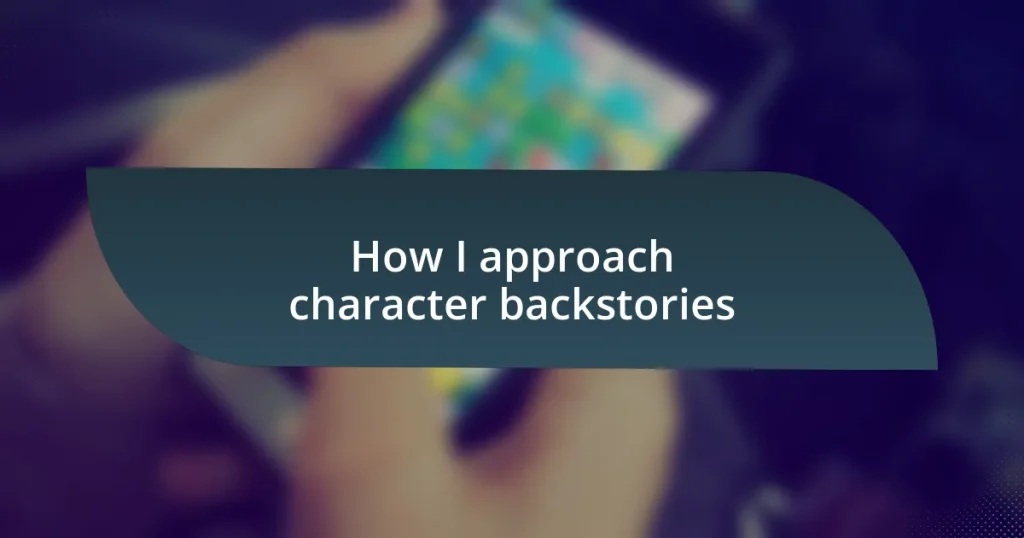Key takeaways:
- Character development involves exploring a character’s backstory to deepen their motivations and evoke empathy in readers.
- Key elements of effective backstories include motivations, internal conflicts, significant relationships, and cultural influences.
- Techniques such as timelines, “What If” scenarios, and character interviews can enhance the depth of character backstories.
- Backstories significantly influence plot dynamics, shaping character decisions and creating emotional complexity in narratives.

Understanding character development
Character development is an intricate journey that goes beyond mere physical traits and dialogue. I remember the first time I created a character who felt so real to me; I found myself asking, “What made them who they are today?” This reflection led me to explore their past experiences, which ultimately shaped their motivations and reactions.
As I delve into a character’s history, I often tap into my own memories, prompting an emotional response. For instance, thinking about a time I faced loss helps me understand a character’s grief. I ask myself how they cope and what lessons they’ve gleaned from their pain. This exploration not only enriches the character but also evokes empathy in the reader.
Understanding character development hinges on the idea that every character has a backstory that informs their present choices. I’ve learned that even the smallest details, such as a cherished childhood memory or an unfulfilled dream, can breathe life into a character, making them relatable and compelling. What drives your characters? I find that engaging with their deepest fears and desires creates depth that resonates with readers long after the story ends.

Importance of character backstories
Character backstories are vital because they serve as the foundation for a character’s motivations and decisions. I remember crafting a character who seemed unpredictable at first, but once I mapped out their past, everything clicked into place. Suddenly, their choices made sense, revealing a complex individual shaped by their experiences. This deeper understanding helps create a more immersive story that captivates readers.
When reflecting on character backstories, I’ve found it helpful to consider several factors that contribute to their depth and relatability:
- Motivations: Understanding what drives a character can illuminate their actions.
- Conflicts: Past struggles, whether internal or external, shape how they react in the present.
- Relationships: Examining significant connections from their past helps build their identity.
- Transformation: Characters evolve through their history, making their journey compelling.
- Resilience: Looking at how they’ve overcome challenges adds layers to their personality.
These elements interweave to create a rich tapestry of an individual’s life, ultimately enhancing the narrative and engaging the reader on a deeper level. Each detail, even minor ones, can add rich context that evokes genuine emotional responses.

Techniques for crafting backstories
One technique I find particularly effective for crafting character backstories is the use of timelines. Establishing a chronological sequence of significant events allows me to visualize a character’s journey clearly. I remember working on a character who faced multiple betrayals throughout their life. By outlining these events on a timeline, I could see not just what happened, but how each moment contributed to their current distrust of others, helping me flesh out their personality authentically.
Another powerful tool I often employ is the “What If” scenario. This technique encourages me to explore alternative paths a character might have taken. For instance, I once imagined how a character would behave if they hadn’t lost their family in an accident. This exercise created a duality within the character, providing potential for growth and conflict as they grappled with their choices. Exploring such scenarios opens up new dimensions to their backstory, making them more multidimensional and relatable.
Lastly, I make a habit of character interviews, where I ask my characters direct questions about their past. This might sound a bit quirky, but it can lead to some surprising revelations. One character, during a fictional interview, revealed a hidden talent for music that stemmed from a childhood filled with loneliness. This insight not only enriched their backstory but also tied into their arc in ways I hadn’t anticipated. This hands-on approach allows for a deeper emotional connection, as if the character is sharing their story directly with me.
| Technique | Description |
|---|---|
| Timelines | Chronological mapping of key events in a character’s life. |
| What If Scenarios | Exploring alternative paths to add depth and conflict. |
| Character Interviews | Direct questioning to uncover hidden traits and insights. |

Elements to include in backstories
When crafting a backstory, I believe incorporating key relationships is crucial. These connections shape a character profoundly, often influencing their motivations and decisions. For instance, I once created a character whose estranged parent played a pivotal role in their life. This relationship added layers of tension and longing, driving the character’s narrative arc and making their journey toward reconciliation more compelling.
Another essential element is the character’s internal conflicts or struggles. I often ask myself: what demons does my character wrestle with? For example, I developed a character who constantly battled feelings of inadequacy after failing to achieve a childhood dream. This internal struggle not only propels the character’s actions but also resonates with readers who may have faced similar feelings of self-doubt. Exploring these conflicts provides depth and relatability, making the character’s journey more engaging.
I’ve also found that including specific cultural or environmental influences can enhance a backstory significantly. Reflecting on a character shaped by their upbringing in a close-knit community, I remember how their values clashed with the larger world, creating vibrant tension. This tension can offer opportunities for growth, pushing the character to grapple with their identity. Isn’t it fascinating how the environments we grow up in silently shape who we become? These elements, when woven seamlessly into a backstory, reveal a character’s complexities and motivations in ways that feel genuine and impactful.

How backstories influence plot
Backstories intricately weave into the plot, creating a rich tapestry of motivations for characters. For example, I once penned a story where a character’s traumatic childhood incident led them to become a fiercely independent adult, untrusting of others. This past dictated their interactions and choices, steering the plot toward unexpected conflict and growth. Isn’t it interesting how a single event can ripple through a character’s journey, influencing every decision they make?
Thinking back to one of my stories, I crafted a character whose backstory revealed a legacy of familial betrayal. As the plot unfolded, this history provided a powerful catalyst for their quest for revenge, driving the story forward in ways I hadn’t initially anticipated. The layers of their past fueled the narrative, intertwining with the choices they faced in the present. Do we not all carry burdens from our past that shape our actions today?
Moreover, the relationships rooted in a character’s backstory can create compelling subplots that enrich the main storyline. In one character’s journey, their backstory involved a childhood friend who turned adversary, sparking a rivalry that deepened throughout the narrative. This ongoing tension added stakes and emotional complexity to the plot, making every interaction charged with significance. Reflecting on these dynamics, aren’t we often more engaged by stories that echo the complexities of our own relationships?

Examples of effective backstories
One memorable example of an effective backstory I created involved a former soldier haunted by his past decisions during combat. The weight of guilt over a comrade’s death fueled his struggle with PTSD, influencing how he approached new relationships and faced challenges. It was remarkable to see how this internal conflict resonated with readers, prompting them to reflect on their own struggles with guilt and forgiveness.
In another story, I developed a character who grew up in a small town where dreams often felt unattainable. This background fueled her relentless pursuit of success in a big city, making her both ambitious and vulnerable. Readers connected deeply with her journey, as they could see parts of themselves in her aspirations and fears—a reminder that our beginnings can shape our paths in profound, sometimes surprising ways.
Then there’s the idea of a character whose tragic backstory involved losing their family in a disaster caused by the very institution they now seek to dismantle. This not only provided a potent motivation for their actions but also created a moral quandary: should they seek justice or revenge? The emotional stakes were incredibly high, drawing readers into a dialogue about the nature of justice itself. Isn’t it fascinating how a character’s past can ignite such complex thoughts and feelings within us?

Revising and refining backstories
Revising a backstory often means peeling away layers to expose the core of a character’s identity. I remember a time when I had a character who seemed one-dimensional, stuck in a predictable narrative of loss. After diving deeper, I discovered that his feelings of abandonment were intricately tied to his ambitions, transforming him into someone who both fears and yearns for connection. Isn’t it interesting how revisiting a backstory can reveal new emotional landscapes?
Refining a backstory requires balance; it’s about knowing when to add depth and when to hold back. In my writing, I’ve found that sometimes less is more. One character’s vague references to a troubled childhood allowed readers to fill in the gaps with their own interpretations, making the backstory feel more personal and relatable. This subtlety can deepen engagement, prompting readers to ask themselves what they might have done in similar circumstances.
As I revise, I also consider how a character’s past impacts their present choices. For instance, I once worked on a character whose unresolved family conflicts shaped her decision-making in a high-pressure situation. This added a fascinating layer of tension and unpredictability to her actions—how much baggage can a character carry before it affects their destiny? These reflections during the revision process can turn a good backstory into an essential part of the character’s journey, something that truly resonates with the audience.











